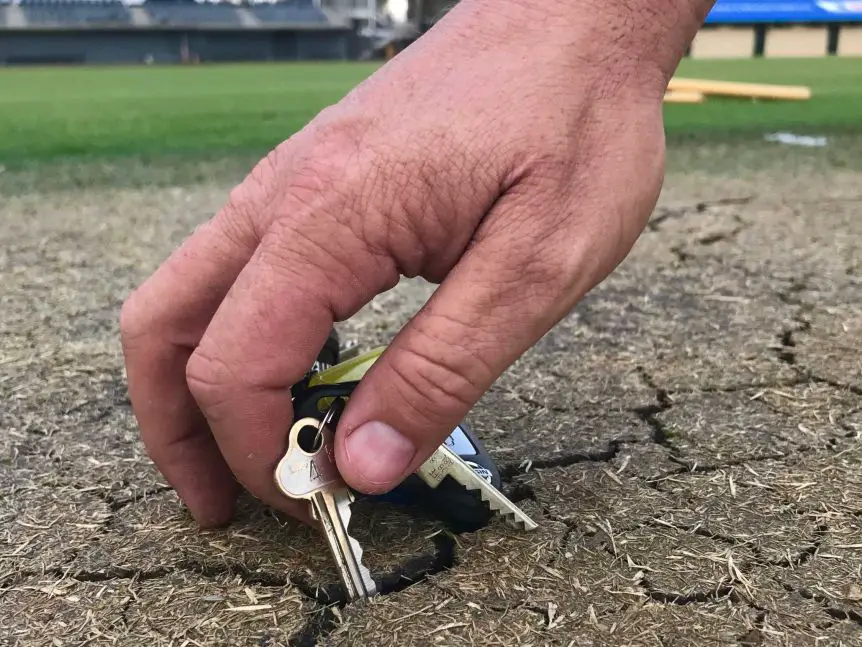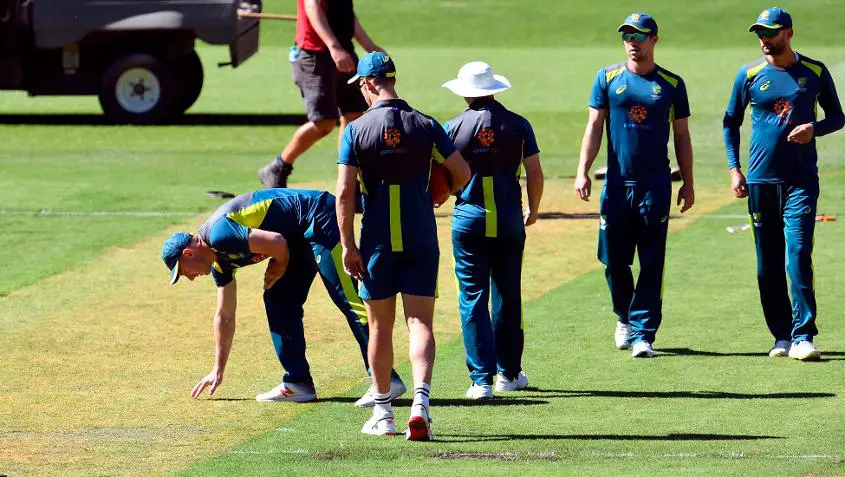When a captain wins the toss before a cricket match, one of the key responsibilities that the captain then has is to decide whether to bat or to bowl. However, this key decision is often based on the captain’s capability to read the pitch.
To read a cricket pitch, you need to assess the amount of grass, moisture content, and the hardness of a cricket pitch. To decide whether to bat or bowl, you may also need to consider the presence of cracks or footmarks, condition of the outfield, and predicted weather forecast.
Learning to read a cricket pitch can be tricky. Let’s take look in more detail at how you read a cricket pitch, including a number of important features to help you distinguish a batting ‘featherbed’ from a seaming ‘green top’ for bowlers.
How to Read a Cricket Pitch?
Knowing how to read a cricket pitch is both an art and a science! Some of it comes through experience, while a good part of it can be learned through correct knowledge!
In order to read the pitch correctly, you need to look at various factors that affect a cricket pitch. Furthermore, knowing when to bat or ball requires you to understand a few additional factors as well which have also been covered by us.
In order to decide whether to bat or bowl first, you need to consider the following factors –
1. Presence of Moisture – Is the Pitch Damp?
An assessment of how damp the pitch is will partially allow you to read it. As a general rule, the damper the pitch the slower it plays, so a batsman has to be particularly wary of the timing of his shots as the ball will ‘sit up’. This also often results in slow scoring or lower scoring matches.
Research published by the West Indies Journal of Engineering has showcased the effect of water content on ball movement on a cricket pitch [link to the research paper]
For a bowler, finding the right length to pitch a delivery can be tricky on a slow wet deck as if the ball holds up it can be easy for a batsman to punish. A pitch which is starting to dry out it will offer a great degree of assistance to spinners wishing to turn the ball.
Pro-Tip:
A good way to asses the presence of moisture if gently rub your palm against the surface of the pitch and see if you feel any moisture on your palm. If yes, it indicates a moist pitch
Cricket pitches also begin to spin when they become worn and dusty. Running your palm over the surface of the pitch should give you some idea of how wet the pitch is.
2. Presence of Grass on a Cricket Pitch
If a pitch has a presence of grass on the pitch, it is more likely to favor the bowlers! Presence of the green grass usually means that there is a bit of moisture underneath the surface of the cricket pitch as the roots of the grass tend to hold moisture.
Thus, if there is green grass present on the pitch, you should choose to bowl first.
An important thing to note here is color of the grass. If the grass is green, then the pitch should be moist and even damp in some cases. However, if the grass is straw-colored, it is a great indicator that the pitch is indeed dry!
Therefore, the color of the grass can often act as a barometer on the behaviour of the pitch.
3. How Hard is the Cricket Pitch?
This is another important factor that can indicate the behaviour of the pitch. Harder pitches tend to push the ball onto the bat, and scoring runs can be easy for the batsmen.

A close examination of the texture of the pitch will determine how hard and flat the pitch is, and therefore whether it will favor bat or ball. A great way to assess the hard nature of the cricket pitch is by using a key and pressing it on the pitch. If the key fails to penetrate the surface, it can be considered a hard pitch.
A very hard cricket pitch is likely to offer pace and bounce to a bowler. Although this can also be an advantage to a batsman too, depending on their technique, as the ball will come on to the bat quicker and can be maneuvered into gaps in the field.
A batsman will also feel he can trust the bounce on a harder pitch to be consistent. A pitch that appears flat is also likely to encourage a batsman to have faith in it.
At the other end of the spectrum, a soft and sticky wicket can often be much more difficult to bat on. This is because the bounce is less likely to be consistent so it becomes tricky for a batsman to anticipate the trajectory and pace of the ball.
4. Presence of Cracks and Footmarks on the Pitch
This is another key factor to look out for. While mere presence or absence of the cracks in itself doesn’t directly determine the behavior of the pitch. However, it gives a good indication on how the pitch may behave later on during the match.
It can play a critical role during a test match as the crickets and the footmarks can really open up as the match progresses and reaches the 4th and 5th day of a Test Match.
When the cracks become loose and the footmarks become prominent, the pitch starts favouring the spin bowlers as the ball start gripping off the pitch, and spins more.
5. Did it Rain the Previous Night?
Rain, and the presence of water on the ground plays a key role in how the pitch may behave. As we have already learned, presence of moisture can determine the behaviour of the pitch. Thus, if it has rained on the day prior to the match, the due and the presence of water can make the pitch favor to the bowlers.
That said, most cricket pitches today or mostly covered using a pitch cover. Therefore, most first class or list A matches may not necessarily affect the pitch with little rain. However, this factor can be critical for other junior level matches.
6. Condition of the Outfield
Although this doesn’t necessarily impact how a pitch behaves, however, it can play a crucial role in deciding whether to bat or bowl after winning the toss.
If the outfield is wet, it will be slower and the chances of the ball running to the boundary will also be lower. Therefore, scoring runs might be a bit difficult.
As the match progresses, however, due to exposure of the sunshine, the outfield might dry up. This may make it easier to score runs while batting second!
7. Consider the Weather Forecast for the Day
This is another one of those factors that do not directly affect the behaviour of the pitch. However, knowing how the weather is expected to be throughout the day can play an important role in determining whether to bat or bowl first.
For instance, if the outfield is damp either due to excess watering or rain on the previous night and the weather forecasts says that it is expected to be cloudy and more rain may be expected, then it is best to bat first after winning the toss as the outfield may become even damper later. Furthermore, the pitch might become moist due to rain later in the day. Moreover, you may also stand benefited from the duckworth-lewis system!
However, if the outfield is damp and the weather forecasts suggest that it will be bright and sunny through the day, then batting second would be a better idea!
8. Historical Performance of the Cricket Pitch
If you have played at a particular ground in the past you may recall how the pitch you played and performed.
In professional cricket certain grounds develop a reputation for how their pitch will play.
The WACA in Australia, partly through the exploits of fast bowlers Dennis Lillee and Jeff Thomson, was notorious as one of the fastest pitches in the world.
The Galle International Cricket Stadium in Sri Lanka, meanwhile, is better known as a spinner’s paradise. In modern professional cricket, a ‘drop-in’ pitch might be used in a ground not purpose-built or solely used for cricket. This pitch will have been prepared away from the ground which might make it even more difficult to read.
Types of Cricket Pitches
The nature of pitches can vary significantly. However, a cricket pitch is broadly classified under mainly 3 types of pitches. These are as follows –
1. Green Pitch
A green pitch usually has a decent amount of green grass cover on it. Such pitches tend to favor mostly fast bowlers or swing bowlers.
A pitch with a good green grass on it usually provides a great battle between the batsmen and the bowlers as the green cover allows the bowlers to swing the ball and tests the capability of the batsmen!
2. Dry and Hard
Such types of pitches usually have no moisture and no cracks on it. It is nice and hard.
Dry and hard pitches are also knowns as a ‘flat pitch’ or a ‘flat track’ as it barely offers any support to the bowlers in most cases. Batting on such type of cricket pitches is a lot easier as the ball comes on to the bat of the batsman.
3. Dusty
Dusty pitches often tend to have a lot of loose soil, presence of cracks and even footmarks on the pitch.
Such cricket pitches don’t last long and tend to wear out faster. A dry and a dusty cricket pitch supports spin bowling as the bowl bounces and spins erratically of the cracks and the footmarks of the bowlers.
How Does the Cricket Pitch Affect the Decision to Bat or Bowl? Tips to Avoid Bad Decision!

Now that you have understood the different types of cricket pitches along with the various factors that you should consider in order to assess the cricket pitch, let’s look at how a cricket pitch can affect your decision to bat or bowl.
We have simplified the decision matrix in the following tabular format for your reference –
| Pitch Assessment | Pitch Behaviour | Win the Toss and? |
| Pitch has Green Grass on it | Expected to favour swing bowling and favour the bowler | Ball first |
| Pitch is hard with no cracks | Pitch will provide good bounce and help the batsman (mostly) | Bat first |
| Pitch is dusty with multiple cracks | Spin bowlers will benefit the most. The pitch will most likely become even more difficult to bat later. | Bat first |
At What Point in the Game does a Pitch help Bowlers and Batsmen?
Anticipating how the pitch will play at various stages of a game is an important skill in reading pitches, especially in matches which last more than one day.
To maximise their chances of success a captain must, on the whole, work under a simple approach: bat when the pitch is best for batting, and bowl when pitch is best for bowling. Taking into account the above factors will help influence the decision.
What is the Worst Cricket Pitch of All Time?
On occasions, though, even the captain cannot contemplate what ‘demons’ may lie in a pitch.
England’s Mike Atherton elected to bat first in a Test match against West Indies in Jamaica in 1998 thinking his side would get the best of a crumbly-looking pitch.
After several overs some balls were leaping up off a length, while others went through at shin height, injuring a number of players.
For the first time in history a Test match was abandoned because of a dangerous pitch. Neither captain could have read the pitch and decided batting or bowling was preferable in those exceptional circumstances, though.
When International Captains Read the Pitch – and Got it Wrong!
A cricket captain can often be remembered for the one time he made the wrong call with a toss after reading a pitch, rather than all the occasions when he got it right.
One example of this was when the then England skipper Nasser Hussain famously misread the pitch at the Gabba in the first Test of the 2002-03 Ashes series. Hussain won the toss in Brisbane and, partially on the advice of his team-mates, asked Australia to bat first – they ended day one 364-2 en route to an emphatic victory.
Australia captain Ricky Ponting also memorably made a blunder of his own in the 2005 Ashes when he elected to bowl first in the Edgbaston Test.
With some damp weather around Ponting decided to bowl first, thinking there was moisture in the pitch, but in fact, conditions were ideal for batting and would continue to get better through the course of the contest. England’s 407 on day one proved crucial in their victory.
Final Thoughts
Part of the beauty of cricket is that it is played on a surface where the living and breathing forces of nature are at work. Climate and weather can both have a huge impact on how a pitch may perform in match conditions.
Reading a cricket pitch is a skill a cricket captain must be able to master: a wrong call can sometimes cost a team a game before a ball has been bowled, even if he or she has a stronger side at their disposal. Reading a pitch can play a huge part in selection: a captain would be foolish to a five-pronged seam attack on a worn pitch with cracks which favor spin.
The ability to read a pitch is not an exact science, but there are factors a cricket captain can take into account to give themselves a competitive advantage. Sometimes a pitch can look like a batsman’s paradise but is actually more bowler-friendly and vice versa. As we have seen, even the best captains in the world read it wrongly on occasions!
Finally, before we sign off on this article, let’s enjoy the vintage Tony Greig who literally turned the cricketing world on its head with his famous style of pitch report!
